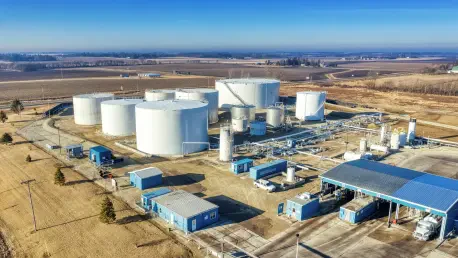Recent developments in international trade have brought to light a critical issue as new U.S. sanctions on Iranian petroleum exports target a key crude oil terminal in China, directly affecting Sinopec, the nation’s largest refining company. These sanctions, announced in a bold move by Washington, zero in on the Rizhao Shihua Crude Oil Terminal in Shandong province, a facility handling roughly one-fifth of Sinopec’s crude oil imports. Partially owned by a logistics unit of Sinopec, this terminal has been designated by the U.S. Treasury for receiving Iranian oil through sanctioned vessels, placing it at the heart of a broader strategy to curb Iran’s oil trade with China, its largest market. This action not only disrupts a vital supply chain but also escalates tensions between the U.S. and China at a delicate moment in their diplomatic relations. The implications of such measures extend beyond mere economics, weaving into the fabric of geopolitical maneuvering and raising questions about the future of energy trade in the region.
Targeting a Critical Supply Hub
The significance of Shandong province as a major refining hub cannot be overstated, especially since it serves as the primary destination for oil from sanctioned nations like Iran, Venezuela, and Russia. The Rizhao terminal, capable of accommodating very large crude carriers with capacities up to 2 million barrels each, plays a pivotal role in this network. However, with the latest sanctions affecting this facility and four other terminals in the province, half of Shandong’s capacity for handling such massive shipments is now under restriction. Industry analysts, including experts from FGE, suggest that the impact of these measures could be more pronounced than previous sanctions on Chinese terminals. While only 10-20% of Rizhao’s imported oil originates from sanctioned sources, short-term disruptions are anticipated, with vessels likely redirecting non-sanctioned cargo to alternative ports in the region. This logistical challenge underscores the vulnerability of China’s oil import infrastructure to external policy pressures and highlights the strategic importance of maintaining diverse supply routes.
Geopolitical Ripples and Economic Challenges
Beyond operational hurdles, these sanctions signal a deeper undercurrent of strain in U.S.-China relations, particularly as they coincide with the anticipation of high-level talks between the two nations’ leaders. The timing of this move, following China’s recent tightening of rare earth export controls, suggests a tit-for-tat dynamic in trade and geopolitical strategies. The U.S. continues to leverage secondary sanctions to restrict Iran’s oil exports, even in key markets like China, creating a complex web of economic and diplomatic challenges. For Sinopec, which has reportedly avoided direct purchases of Iranian oil, the scrutiny over the terminal’s dealings with sanctioned vessels poses reputational and logistical risks. The broader effect is a potential reevaluation of import strategies across Shandong’s refining hub, where energy trade becomes a pawn in a larger geopolitical chess game. Reflecting on past actions, these sanctions reveal Washington’s determination to limit Iran’s trade avenues, even at the cost of straining ties with Beijing, leaving a lasting mark on global oil flows and international relations. Moving forward, stakeholders must navigate these turbulent waters by exploring alternative ports and reinforcing diplomatic dialogue to mitigate future disruptions.









